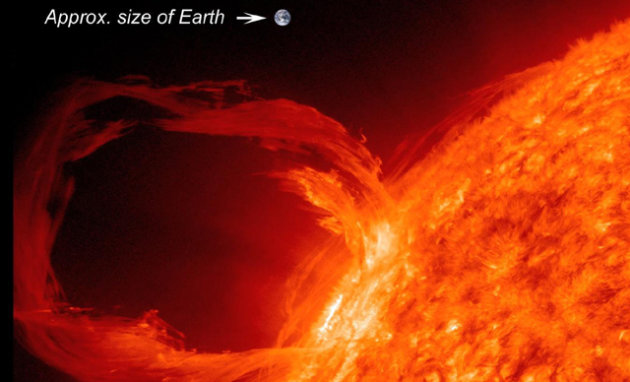In the summer of 2012, when all the hype about the supposed Dec. 21 Mayan Apocalypse was really starting to kick into high-gear, it seems that we only barely avoided a real catastrophe, when three solar eruptions in late July combined to produce a solar storm that could have caused chaos if it had hit Earth.
As scientists monitor the sun for any potentially-dangerous space weather events, it's typically the most powerful solar flares — the X-class flares — that get the most attention. These are the ones that throw off powerful blasts of high-energy particles, as well as immense coronal mass ejections which can cause intense geomagnetic storms when they impact on Earth's magnetic field. Both of these effects can take a toll on our technologies, especially on orbiting satellites and spacecraft, but also on power grids and electronics on the Earth's surface.
One of the most famous of these events, known as the Carrington Event, happened in early September 1859, when a solar flare blasted out from the sun that scientists estimate was an X45-class (when the scale of the different levels, C, M and X are typically ranked from 0-9). It was the most powerful solar flare ever recorded. It caused highly-active auroras that extended much farther away from the polar regions than they they usually do, and it disrupted telegraph service across Europe and North America, with some telegraph operators actually getting shocks from their equipment due to the charge the solar storm induced along the telegraph lines.
However, although these really big flares are definitely a threat to us, a new study is saying that we have to start looking at smaller solar flares as potentially being bigger threats, because their effects can combine together to produce something approaching a Carrington-level event. This isn't just speculation or modeling on the researcher's part, though. Such an event happened in July 2012, but it managed to miss Earth by 9 days. That may seem like a pretty wide margin, but 9 days represents only 2.5 per cent of our year, which is cutting it really close.
"Had it hit Earth, it probably would have been like the big one in 1859, but the effect today, with our modern technologies, would have been tremendous," said study co-author Janet Luhmann, a UC Berkeley physicist who is part of the team that works with the Solar Terrestrial Relations Observatory that detects these eruptions, in a statement.
A study from 2011 estimated that if a similar event were to happen today, the total cost of the damages could reach between $1 trillion and $2 trillion, and the effects of the satellite losses and power grid failures could be felt for years after.
It all started on July 19, 2012, when an M7.7-class flare blasted out from the sun's surface, just as the sunspot where it originated from passed beyond our view of it, as seen in this video from NASA's Solar Dynamics Observatory.
Then, before that space could fill up again, two more solar flares went off on July 23rd, just 10 to 15 minutes apart from one another, as shown in this video:
The STEREO-A satellite, which circles the sun in the same orbit as Earth, but leading us by an ever-increasing amount of time, was in the direct path of this CME and recorded its effects:
The threat here comes from the fact that, although X-class flares only happen once in a while (even during solar maximum), these M-class flares happen much more often. This increases the chance that we'll be hit by these combined CMEs.
"People keep saying that these are rare natural hazards, but they are happening in the solar system even though we don’t always see them," Luhmann said in the statement. "It's like with earthquakes — it is hard to impress upon people the importance of preparing unless you suffer a magnitude 9 earthquake."
Other researchers agree with her. Back in December of last year, Daniel Baker, the director of the University of Colorado-Boulder's Laboratory for Atmospheric and Space Physics, said in a press release that this event should be taken as a new best estimate of a worst case scenario, but he and his colleagues believe that policymakers are not going to pay attention to these events until we're hit by a really big one.
"The Carrington storm and the 2012 event show that extreme space weather events can happen even during a modest solar cycle like the one presently underway," he said in the statement. "Rather than wait and pick up the pieces, we ought to take lessons from these events to prepare ourselves for inevitable future solar storms."
How can we protect ourselves from these storms? There's no way to avoid one if it's on the way towards us, but we can manage things here on the ground to lessen or avoid the impact, mainly by strengthening our power grid and developing effective forecasting systems that would let us take vulnerable 'nodes' of a grid offline until the storm passed. NASA's 'Solar Shield' project has been looking at this for a few years, and other scientists have been researching how the Earth itself protects us from these effects.

No comments:
Post a Comment
Through this ever open gate
None come too early
None too late
Thanks for dropping in ... the PICs